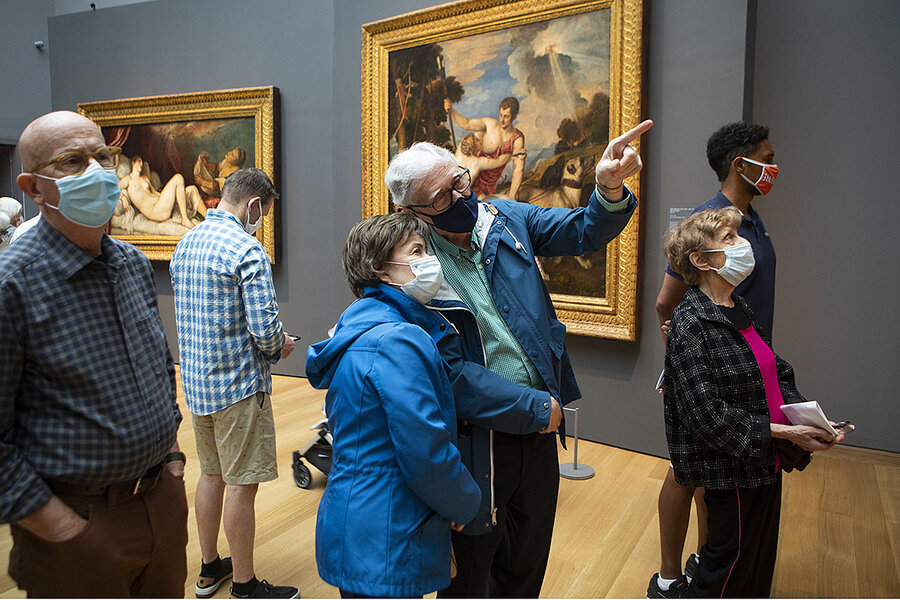Titian paintings reunite after centuries apart. How receptive are museumgoers?
Loading...
| Boston
When Titian created six masterpieces for King Philip II of Spain centuries ago, the Renaissance artist pioneered a revolutionary style in a bid for primacy against other art forms.
“It’s not hyperbole to say that these paintings transformed the history of Western painting,” says Nathaniel Silver, curator of the Isabella Stewart Gardner Museum in Boston, which recently opened an exhibit reuniting the group.
Why We Wrote This
Where does viewing art fit among our other attention-demanding options? In Boston, a rare exhibition of Renaissance paintings tests the appeal of quiet contemplation.
Viewing these works more than 450 years later, it occurred to me that Titian has to compete, yet again, with other art forms. This time he’s vying for attention against youthful mediums such as TikTok. Many of today’s leisure options consist of digital content that’s interactive and immediately available. By contrast, Titian’s canvases are stationary and require a visit to view them. A more fundamental question is whether Titian’s mythological scenes, which depict sexual violence with a prurient gaze, speak to our contemporary values.
Then again, the exhibition makes a compelling counter argument for quiet contemplation about the arc of human history. Taken on those terms, Titian’s paintings still hold their own against contemporary art forms. The Gardner’s innovative presentation, which incorporates the perspective of modern social mores, suggests that museums can still find a niche for our attention.
What would the great artist Titian have thought of TikTok? I pondered that question when I visited the landmark exhibition “Titian: Women, Myth & Power” at the Isabella Stewart Gardner Museum.
For most of Titian’s life, which paralleled the crest of the Renaissance period, painting was overshadowed by other artistic mediums. The printing press had elevated the popularity of drama and poetry, which was sometimes accompanied by music. So when Titian created six masterpieces for King Philip II of Spain – reunited for the first time in several centuries in this exhibition – the artist pioneered a revolutionary style in a bid for primacy against other art forms. The Italian broke with finely detailed techniques of the era for looser, impressionistic brushstrokes that invited one’s eye to fill in the specifics.
“It’s not hyperbole to say that these paintings transformed the history of Western painting,” Nathaniel Silver, curator of The Isabella Stewart Gardner Museum, tells me.
Why We Wrote This
Where does viewing art fit among our other attention-demanding options? In Boston, a rare exhibition of Renaissance paintings tests the appeal of quiet contemplation.
Viewing these works more than 450 years later, it occurred to me that Titian has to compete, yet again, with other art forms. This time he’s vying for our attention against youthful mediums such as TikTok and video games. Many of today’s leisure options consist of hi-def digital content that’s immersive, interactive, and immediately available to our scrolling fingertips. By contrast, Titian’s slabs of oil and canvas are stationary, two-dimensional, and require a visit to view them in person. A more fundamental question is whether Titian’s mythological scenes, which depict sexual violence with a prurient gaze, speak to our contemporary values.
Then again, the exhibition makes a compelling counter argument for quiet contemplation about the arc of human history. Taken on those terms, Titian’s paintings still hold their own against contemporary art forms. The Gardner’s innovative presentation, which incorporates the perspective of modern social mores, suggests that museums can still find a niche for our attention.
“Museums are in a really interesting space because they still have this cachet of being the symbol of authority,” says Ben Davis, national art critic at Artnet News, an online publication. “But at the same time, they are just this really small node in this giant information network that everybody’s consuming now.”
Museums can stand out by being a little out of step with popular culture, says Mr. Davis, but he adds that there’s great pressure on museum directors to cater to what’s fashionable.
“Titian: Women, Myth & Power” isn’t necessarily hip – when was the last time the Renaissance Art was chic? – but it is a blockbuster show. Several of these paintings have never traveled outside of Europe. The Gardner Museum, which owns Titian’s greatest work, “The Rape of Europa” (1559-1562), is the sole American venue for the traveling exhibition, which runs through January 2. The Italian artist’s six “poesie,” or painted poems, inspired by the work of Roman poet Ovid, were initially displayed in Philip II’s palace in Madrid. Then they wound up in different collections. Each of these paintings are the equivalent of hit singles. Viewed together again at last, it’s apparent that they form a classic album.
The show has been billed as a one-off reunion, likely never to be repeated. But nowadays, people are pulled in so many directions for entertainment – and life – that they are often hard-pressed to find time to visit museums. (And some people are still hesitant to visit crowded indoor spaces due to the pandemic.) That’s why The Boston Globe’s rave review of the exhibition pleaded with readers to make the effort to go, calling it “an extreme lesson in the value of showing up.” Visitors to the Titian display echo that sentiment.
“You see the scope of the painting, the largeness of it, which doesn’t really come across from a book that I’ve seen or any online representation,” says David Jackson from Chicago, visiting the museum with his brother, Steven. “The subtlety of the colors really comes out when you see it in person. Also the atmosphere of all these people circling around, looking at it, adds something to the experience. It’s something that touches people.”
During my two visits to the exhibition, there were waiting lines outside. Yet teenage attendees were as scarce as fully clothed females in Titian’s paintings. The Gardner has made a concerted effort to speak to younger generations by offering companion exhibits with a social justice perspective.
A short film, “The Rape of Europa” by Mary Reid Kelley and Patrick Kelley, delivers a feminist critique via risqué limericks that would have made even Chaucer blush. Visitors can also scan QR codes with their cellphones to listen to audio commentaries by contemporary artists responding to Titian’s representation of women, nonconsensual sex, and patriarchal power. (It’s an ingenious way to engage visitors so they’re not distracted by other apps on their phone.) For instance, Matisse DuPont, a transgender educator, artist, and consultant, shares an LGBTQ interpretation of “Diana and Actaeon.” Artist Johnette Marie Ellis explores a white savior complex in “Perseus and Andromeda,” wondering why an Ethiopian princess is rescued by “a semblance of a man of Greece.”
Mr. Silver, the curator, says that The Washington Post’s rave review of the exhibition – with art critic Sebastian Smee raising the idea that it is “the art event of the year, and possibly the decade” – attracted hundreds of comments by readers. There was a raging argument between those who appreciated the commentary by contemporary artists in the show and those who loathed their inclusion.
“I go to conferences as a scholar all the time where people will tell you that the Renaissance is dead,” says Mr. Silver. “I can’t think of a contemporary art exhibition that generates this much discussion and debate. And to me, that suggests that the Renaissance and the old master paintings are a lot more relevant and engaging to people than most specialists would have you believe.”
During one of my visits to the exhibition, I overheard a teenager explain to her mother that some women in the paintings wear their curly blonde hair up so they’re less sexually provocative to men. (Titian only grants them that modicum of modesty – they’re all naked.) Turns out that teen, Elena Comellas, a student at Wellesley College from Puerto Rico, recently visited Greece to study classics. I asked her why so few of her peers have attended this exhibition.
“I think it’s because of social media and because there’s so many distractions nowadays that people aren’t looking towards art,” she said. “There’s so many other things that are available and maybe more interesting to them.”
Indeed, a new Deloitte survey of Generation Z consumers found that 26% favor video games as their favorite pastime. Next on the list came music at 14%, followed by browsing the internet (12%), and interactions on social platforms (11%). Watching movies or television shows ranked even lower. As for visiting art museums? To borrow a Gen Z slang term, that’s just cheugy (translation: passé).
But the anxiety and depression among young people, often linked to social media, presents an opportunity, says Mr. Davis, the art critic. Savvy museums could ally themselves with the growing mindfulness and meditation movement.
“The first museums were really supposed to be spaces of solace in the face of new industrialization,” says Mr. Davis. “Its slowness, things that people find that are making it a tough sell in a digital economy, might actually be strengths. These are repositories of slower forms of looking and attention and historical thinking.”
The Gardner museum, which boasts a serene indoor atrium, certainly invites quiet contemplation. Inside the intimate Hostetter Gallery, one can grapple with the complexities and contradictions in Titian’s compositions. His scenes of anguished violence often feature a lascivious gaze. But there’s also great humanity in the tenderness and compassion of many of the characters.
Another thing I noticed: The grandeur of these paintings easily commands visitors’ attention for long periods of time. Student Farid Mazrui from Buffalo, New York, says Titian’s “breathtaking” work makes him want to learn more about classic mythology. The mathematics major adds that he valued being around other people in a quiet environment.
“It’s healthy to disconnect, you know, just turning your phone off for an hour and you come to experience it,” Mr. Mazrui tells me. “It makes you live in the moment.”












